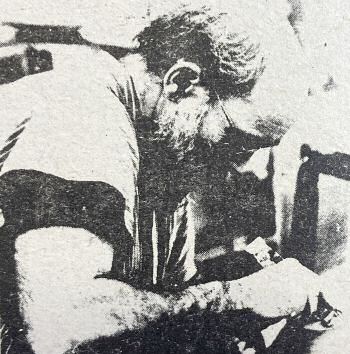A Point of View
Having been asked to say something about ash
glazing I am straightaway made to think of Geoffrey
Whiting's assertion that one can come to know a few
friends intimately but only ever achieve a passing
acquaintance with a crowd, and am reminded that
an approach to glazing is but part of a general
approach to the work which in turn, is merely an
extension of one's approach to life.
Ash glazes began, as I am sure every potter is aware
quite accidentally in the East when it was observed
that wood ash falling on the exposed ware during firing
formed a crude glaze. It was a fairly obvious next step
to apply wood ash deliberately to the pots before placing
in the kiln, and an equally obvious second step to try
mixing the wood ash with some other material. This
was initially no more than the body clay itself and,
a little later, whatever clay or stone was locally at
hand. In this way the glaze; being no more than a re-organising of the materials and processes already in
use is completely unforeign to the pot, just a natural
extension.
In a society that is in danger of losing its balance
at a time when too much emphasis is placed on technology and monetaryism it is not easy to retain intact
one's integrity and purity of purpose as a craftsman.
But I am encouraged and reassured when I see work
such as that exhibited recently by Richard Batterham
at the British Crafts Centre, to know that it is still
possible, when one is clear enough, honest enough,
and in touch with intrinsic values to make work
which speaks in a clear quiet voice, without resort to
gimmackry, and with a love of life, in spite of the
pain, and the joy of just being, and working.
Pots such as these, no less than those historic examples we admire, are the product of an empathy
with one's particular environment where use is made,
so far as is possible, of what materials are offered
locally, acknowledging their virtues, accepting their
shortcomings, in much the same way as we do with
people. Such pots come to flower, as do wild flowers
in time with the natural rhythm of things, unforced.
If one is content with a few friends one knows and
is humble enough to see that one is but a part of the
whole process, and that the materials themselves have
an important contribution to make, then it is possible
I believe, given, time, commitment and sensitivity, to
form a relatiionship with and understanding towards
the materials of sufficient depth to enable, (even now
in a society where pursuit of fame or profit threatens
genuine human expression) pots to be made which
have real beauty and can enrich human experience.
What is important is the motive, and this surely has
to be love love of the materials, love of the work,
love of the pots.
"As in their general philosopy the ancient
Chinese aimed to co-operate and conform with
natural forces, so in their arts they aimed to
obtain the results they wanted by cajoling and
flattering their raw materials so that in the
product the full beauty and character of
those materials was brought into play.They
used persuasion and diplomacy rather than
coercion. The European tendency, at least
in recent times, is so to handle and control
the material that it will do what it is told
to do and not give trouble. We use coercion
instead of persuasion" - Michael Cardew
Perhaps we should always remember that in was
Bernard Leach who reintroduced the craft of pottery
to us in the first quarter of this century and that he
learned from the Japanese, who have the wisdom to
know that creative endeavour, the pursuit of beauty
is what art is, and do not make the supercilious and
stupid distinction between function and non function.
He brought with him a new aesthetic which placed
emphasis on the quieter values - restraint, even austerity
in which material is handled lovingly but directly so
that the vitality of the finished pot is a direct result
of the process by which it was made. There are no
unnecessary embelishments, decoration is subordiate
to form and the western obsession with clinical precision.
and symmetry does not exist. He broadened our concept
of beauty and increased our aesthetic vocabulary.
It would be a mistake to allow ourselves to become
victims of a philistine public, influenced by "experts"
who usually turn out to "deal" in the work of those
potters whose virtue they proclaim never was there
a better example of the blind leading the blind'
It was Bernard Leach who said "The making of the
good pot is worth any sacrifice, including life itself"
Perhaps we do not have that kind of commitment.
Arguing for simple honest materials I would pose
this question. With all our modern technology are the
pots we make any better than those made by potters
throughout history? who used a few simple materials
available to them with respect and understanding.
"....A potter is not just someone who makes
for the local market. He is someone who
makes objects with a real concern for the
qualities of those objects which exist beyond
not excluding, but beyond their simple utility
Someone who makes pots with love. That is
a quality that can be trans." - John Reeve
